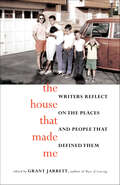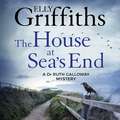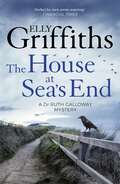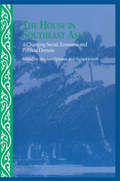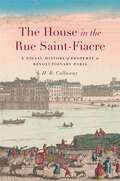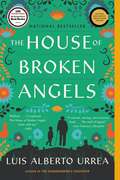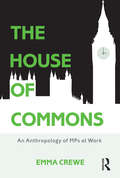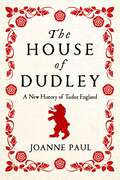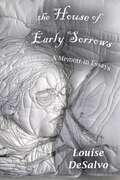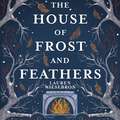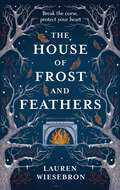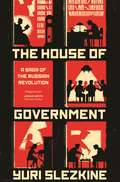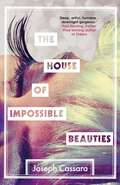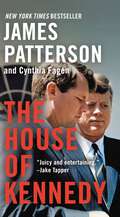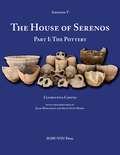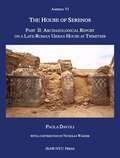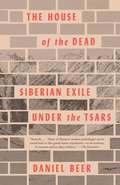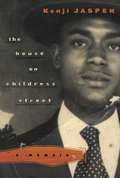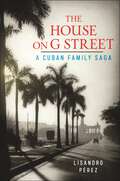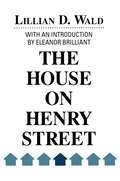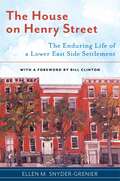- Table View
- List View
The House That Made Me: Writers Reflect on the Places and People that Defined Them
by Grant JarrettHome—the place where we were born, where we learned our first lessons, where family was defined. The very notion evokes powerful feelings, feelings as individual as our fingerprints, as enduring as the universe and as inescapable as gravity. In this candid, evocative collection of essays, a diverse group of acclaimed authors reflects on the diverse homes, neighborhoods, and experiences that helped shape them—using Google Earth software to revisit the location in the process. Moving and life-affirming, this poignant anthology gives fresh insight into the concept of Home. This anthology includes 19 essays by an array of diverse award-winning authors, including: • Tim Johnston, author of Descent and winner of the O. Henry Prize, the New Letters Award for Writers, and the Gival Press Short Story Award • Laura Miller, culture columnist at Slate and co-founder of Salon.com • Porochista Khakpour, author of The Last Illusion and recipient of the 2012 National Endowment for the Arts (NEA) Literature Fellowship in Creative Writing (Prose) • Lee Upton, author of The Tao of Humiliation, named one of “Best Books of 2014” by Kirkus Reviews • Pamela Erens, author of the critically acclaimed novel The Virgins • Jeffery Renard Allen, author of Song of the Shank and winner of the Ernest J. Gaines Award for Literary Excellence and the Whiting Writer's Award
The House That Sugarcane Built: The Louisiana Burguières
by Donna McGee OnebaneThe House That Sugarcane Built tells the saga of Jules M. Burguières Sr. and five generations of Louisianans who, after the Civil War, established a sugar empire that has survived into the present. When twenty-seven-year-old Parisian immigrant Eugène D. Burguières landed at the Port of New Orleans in 1831, one of the oldest Louisiana dynasties began. Seen through the lens of one family, this book traces the Burguières from seventeenth-century France, to nineteenth- century New Orleans and rural south Louisiana and into the twenty-first century. It is also a rich portrait of an American region that has retained its vibrant French culture. As the sweeping narrative of the clan unfolds, so does the story of their family-owned sugar business, the J. M. Burguières Company, as it plays a pivotal role in the expansion of the sugar industry in Louisiana, Florida, and Cuba. The French Burguières were visionaries who knew the value of land and its bountiful resources. The fertile soil along the bayous and wetlands of south Louisiana bestowed on them an abundance of sugarcane above its surface, and salt, oil, and gas beneath. Ever in pursuit of land, the Burguières expanded their holdings to include the vast swamps of the Florida Everglades; then, in 2004, they turned their sights to cattle ranches on the great frontier of west Texas. Finally, integral to the story are the complex dynamics and tensions inherent in this family-owned company, revealing both failures and victories in its history of more than 135 years. The J. M. Burguières Company's survival has depended upon each generation safeguarding and nourishing a legacy for the next.
The House at Sea's End: The Dr Ruth Galloway Mysteries 3 (The Dr Ruth Galloway Mysteries #3)
by Elly GriffithsWNNER OF THE 2016 CWA DAGGER IN THE LIBRARY. The shadow of the Second World War looms dark over the third chilling mystery for Dr Ruth Galloway. Some buried secrets shouldn't be uncovered.'A melancholy setting, an eerie discovery, a lone investigator... perfect for the long winter evening' Financial TimesDr Ruth Galloway is called in by a team of archaeologists investigating coastal erosion on the north Norfolk coast, when they unearth six bodies buried at the foot of a cliff. They seem to have been there a very long time. Ruth must help discover how long, and how on earth they got there. Ruth and DCI Nelson are drawn together once more to unravel the past. Tests reveal that the bodies have lain, preserved in the sand, for sixty years. The mystery of their deaths stretches back to the Second World War, a time when Great Britain was threatened by invasion. Ruth thought she knew the history of Norfolk - she's about to find out just how wrong she was, and how far someone will go to keep their secrets buried.
The House at Sea's End: The Dr Ruth Galloway Mysteries 3 (The Dr Ruth Galloway Mysteries #3)
by Elly GriffithsThe shadow of the Second World War looms dark over this chilling mystery starring forensic archaeologist Dr Ruth Galloway. Some buried secrets shouldn't be uncovered.'Brilliant on the eerie landscape of the Norfolk coast' Sunday TimesDr Ruth Galloway is called in by a team of archaeologists investigating coastal erosion on the north Norfolk coast, when they unearth six bodies buried at the foot of a cliff. They seem to have been there a very long time. Ruth must help discover how long, and how on earth they got there. Ruth and DCI Nelson are drawn together once more to unravel the past. Tests reveal that the bodies have lain, preserved in the sand, for sixty years. The mystery of their deaths stretches back to the Second World War, a time when Great Britain was threatened by invasion. Ruth thought she knew the history of Norfolk - she's about to find out just how wrong she was, and how far someone will go to keep their secrets buried.
The House in Southeast Asia: A Changing Social, Economic and Political Domain (Nias Studies In Asian Topics Ser. #No.28)
by Stephen Sparkes Signe HowellExplores the concept of 'house' in the context of Levi-Strauss' idea of the house as a link between kinship-based societies and class societies, developing this further into an examination of a conjuncture of architecture, people and symbolism.
The House in the Rue Saint-Fiacre: A Social History of Property in Revolutionary Paris (Harvard Historical Studies)
by H. B. CallawayA bold account of property reform during the French Revolution, arguing that the lofty democratic ideals enshrined by revolutionary leaders were rarely secured in practice—with lasting consequences.Property reform was at the heart of the French Revolution. As lawmakers proclaimed at the time, and as historians have long echoed, the Revolution created modern property rights. Under the new regime, property was redefined as an individual right to which all citizens were entitled. Yet as the state seized assets and prepared them for sale, administrators quickly found that realizing the dream of democratic property rights was far more complicated than simply rewriting laws.H. B. Callaway sifts through records on Parisian émigrés who fled the country during the Revolution, leaving behind property that the state tried to confiscate. Immediately, officials faced difficult questions about what constituted property, how to prove ownership, and how to navigate the complexities of credit arrangements and family lineage. Mothers fought to protect the inheritances of their children, tenants angled to avoid rent payments, and creditors sought their dues. In attempting to execute policy, administrators regularly exercised their own judgment on the validity of claims. Their records reveal far more continuity between the Old Regime and revolutionary practices than the law proclaimed. Property ownership continued to depend on webs of connections beyond the citizen-state relationship, reinforced by customary law and inheritance traditions. The resulting property system was a product of contingent, on-the-ground negotiations as much as revolutionary law.The House in the Rue Saint-Fiacre takes stock of the contradictions on which modern property rights were founded. As Callaway shows, the property confiscations of Parisian émigrés are a powerful, clarifying lens on the idea of ownership even as it exists today.
The House of Beauty: Lessons from the Image Industry
by Arabelle Sicardi"When I tell you that beauty is a monster, I need you to know it is my favorite kind." So begins Arabelle Sicardi’s blazingly original collection of essays. A former beauty editor, Arabelle has devoted their entire adult life to the subject of beauty—they have analyzed it, criticized it, praised it, benefited from it, loathed it. Now, in The House of Beauty, they get to the contradictions at the heart of it: beauty and horror, two sides of the same coin. With their signature blend of intellectual rigor and poetic sensibility, Arabelle explores how beauty myths are crafted, sold, and weaponized, from corporate boardrooms to your local nail salon. Follow alongside Arabelle as they trace the global trail of the shimmering mica in your beauty products, choose-your-own-adventure-style, or journey into the past to unearth the sinister connection between fragrance and fascism. Bear witness as they visit a tech convention focused on the next horrifying frontier of body modification, or as they ask what’s at stake in the braids we weave in our hair. Sharp yet tender in their observations, Arabelle challenges readers to reconsider beauty as more than a product of consumption, inviting a vision of beauty rooted in community and self-care, one that transcends industry-driven ideals. Equal parts exposé and cultural reckoning, The House of Beauty cracks open an industry that sells dreams and wields power. Once you have encountered Arabelle’s words, there is no looking back.
The House of Broken Angels
by Luis Alberto UrreaIn his final days, beloved and ailing patriarch Miguel Angel de La Cruz, affectionately called Big Angel, has summoned his entire clan for one last legendary birthday party. But as the party approaches, his mother, nearly one hundred, dies, transforming the weekend into a farewell doubleheader. Among the guests is Big Angel's half brother, known as Little Angel, who must reckon with the truth that although he shares a father with his siblings, he has not, as a half gringo, shared a life. <p><p> Across two bittersweet days in their San Diego neighborhood, the revelers mingle among the palm trees and cacti, celebrating the lives of Big Angel and his mother, and recounting the many inspiring tales that have passed into family lore, the acts both ordinary and heroic that brought these citizens to a fraught and sublime country and allowed them to flourish in the land they have come to call home. <p> Teeming with brilliance and humor, authentic at every turn, The House of Broken Angels is Luis Alberto Urrea at his best, and cements his reputation as a storyteller of the first rank.
The House of Commons: An Anthropology of MPs at Work
by Emma CreweThe House of Commons is one of Britain's mysterious institutions: constantly in the news yet always opaque. In this ground-breaking anthropological study of the world’s most famous parliament, Emma Crewe reveals the hidden mechanisms of parliamentary democracy.Examining the work of Members of Parliament – including neglected areas such as constituencies and committees – this book provides unique insights into the actual lives and working relationships of parliamentarians. 'Why do the public loathe politicians but often love their own MP?' the author asks. The antagonistic façade of politics irritates the public who tend to be unaware that, backstage, democracy relies on MPs consulting, compromising and cooperating across political parties far more than is publicly admitted. As the book shows, this is only one of myriad contradictions in the labyrinths of power. Based on unprecedented access and two years of interviews and research in the Palace of Westminster and MPs’ constituencies, The House of Commons: An Anthropology of MPs at Work challenges the existing scholarship on political institutions and party politics. Moving beyond the narrow confines of rational choice theory and new institutionalism, Emma Crewe presents a radical alternative to the study of British politics by demonstrating that all of its processes hinge on culture, ritual and social relations. A must-read for anyone interested in political anthropology, politics, or the Westminster model.
The House of Condulmer: The Rise and Decline of a Venetian Family in the Century of the Black Death (The Middle Ages Series)
by Alan M. StahlHow a lower patrician Venetian family strove for status and wealth over the course of the fourteenth and early fifteenth centuriesThe House of Condulmer tells the story of a lower patrician Venetian family in the wake of the Black Death, as they strove for status and wealth over the course of the fourteenth and early fifteenth centuries. The Condulmers experienced mixed fortunes in their efforts at social mobility. Exiled after their participation in a failed revolt against the Venetian state, they nevertheless managed to accrue a great deal of wealth in the period before the Black Death. In the aftermath of the plague, which ravaged Venice and wiped out many lines of the family, the fortune of the Condulmers was concentrated in two main branches, whose members are the subject of this book.Through original research drawing on hundreds of unpublished archival sources, Alan M. Stahl traces the careers and changing personal circumstances of five members of the Condulmer family: Jacobello, who used his civic participation and donations to achieve noble status for himself and his descendants but impoverished himself and his family in the process; Vielmo, a moneychanger who paraded around in the trappings of wealth, attempting to imitate the appearance of his noble cousins; Franceschina, who used her power over dowries to get noble husbands for her daughters and stepdaughters; Simoneto, who achieved great wealth through Mediterranean commerce but lost it in the crash of the bank in which he was a partner; and Gabriele, who would eventually become one of the most consequential and reviled popes of the Renaissance, Eugene IV.The House of Condulmer brings readers into the world of intrigue, finance, religion, and plague in medieval Venice, capturing the vicissitudes of life in the one of the wealthiest cities of the world on the eve of the Renaissance.
The House of Dudley: A New History of the Tudor Era
by Joanne PaulThe shocking and extraordinary story of the most-conniving, manipulative Tudor family you've never heard of—the dashing and daring House of Dudley.Each Tudor monarch made their name with a Dudley by their side—or by crushing one beneath their feet. The Dudleys thrived at the court of Henry VII, but were sacrificed to the popularity of Henry VIII. Rising to prominence in the reign of Edward VI, the Dudleys lost it all by advancing Jane Grey to the throne over Mary I. That was until the reign of Elizabeth I, when the family was once again at the center of power, and would do anything to remain there. . . . With three generations of felled favorites, what was it that caused this family to keep rising so high and falling so low? Here, for the first time, is the story of England's Borgias, a noble house competing in a murderous game for the English throne. Witness cunning, adultery, and sheer audacity from history's most brilliant, bold, and deceitful family. Welcome to the House of Dudley.
The House of Early Sorrows: A Memoir in Essays
by Louise DeSalvoWINNER OF THE IASA BOOK AWARD!AMERICAN BOOK AWARD WINNER!As the child of children of immigrants, Louise DeSalvo was at first reluctant to write about her truths. Her abusive father, her sister’s suicide, her illness. In this stunning collection of her captivating and frank essays on her life and her Italian-American culture, Louise DeSalvo centers on her beginnings, reframing and revising her acclaimed memoiristic essays, pieces that were the seeds of longer collections, to reveal her true power as a memoirist: the ability to dig ever deeper for personal and political truths that illuminate what it means to be a woman, a second-generation American, a writer, and a scholar. Each essay is driven by a complex inquiry that examines the personal, familial, social, ethnic, and historical dimensions of identity. Collectively, they constitute a story significantly different from DeSalvo’s memoirs when they first published, where the starkness of their meaning became blunted by material surrounding them. DeSalvo has also restored material written and then deleted—experiences she was too reticent to reveal before, in writing about her sister’s suicide, her husband’s adultery, her own sexual assault. The essays also include new material to shift the ballast of an essay as her life has changed significantly through the years. The House of Early Sorrows is a courageous exploration not only of the DeSalvo’s family life and times, but also of our own.
The House of Frost and Feathers: A sweeping Slavic fantasy fairy tale bursting with magic
by Lauren WiesebronTHE WORLD TEETERS ON THE EDGE OF ETERNAL SLUMBER . . .Marisha's time is running out. She's already lost her family to the sleeping plague, and she fears she'll be next. Penniless and desperate for protection, Marisha is forced to accept a job as apprentice to the notorious koldunya, Baba Zima. Despite Baba Zima's reputation for cruelty, Marisha finds herself drawn into the magical world of koldunry, and is thrust into looking for a cure to the plague - if Marisha finds it, she will finally be free.As the search grows increasingly dangerous and seemingly impossible, Marisha uncovers hidden connections between the sleeping plague, her own family's history, and her haunting dreams: of a masked ball where sleepers are trapped endlessly dancing - and a monstrous beaked man who shadows her every step . . .
The House of Frost and Feathers: A sweeping Slavic fantasy fairy tale bursting with magic
by Lauren WiesebronTHE WORLD TEETERS ON THE EDGE OF ETERNAL SLUMBER . . .Marisha's time is running out. She's already lost her family to the sleeping plague, and she fears she'll be next. Penniless and desperate for protection, Marisha is forced to accept a job as apprentice to the notorious koldunya, Baba Zima. Despite Baba Zima's reputation for cruelty, Marisha finds herself drawn into the magical world of koldunry, and is thrust into looking for a cure to the plague - if Marisha finds it, she will finally be free.As the search grows increasingly dangerous and seemingly impossible, Marisha uncovers hidden connections between the sleeping plague, her own family's history, and her haunting dreams: of a masked ball where sleepers are trapped endlessly dancing - and a monstrous beaked man who shadows her every step . . .
The House of Government: A Saga of the Russian Revolution
by Yuri SlezkineOn the 100th anniversary of the Russian Revolution, the epic story of an enormous apartment building where Communist true believers lived before their destructionThe House of Government is unlike any other book about the Russian Revolution and the Soviet experiment. Written in the tradition of Tolstoy's War and Peace, Grossman’s Life and Fate, and Solzhenitsyn’s The Gulag Archipelago, Yuri Slezkine’s gripping narrative tells the true story of the residents of an enormous Moscow apartment building where top Communist officials and their families lived before they were destroyed in Stalin’s purges. A vivid account of the personal and public lives of Bolshevik true believers, the book begins with their conversion to Communism and ends with their children’s loss of faith and the fall of the Soviet Union. Completed in 1931, the House of Government, later known as the House on the Embankment, was located across the Moscow River from the Kremlin. The largest residential building in Europe, it combined 505 furnished apartments with public spaces that included everything from a movie theater and a library to a tennis court and a shooting range. Slezkine tells the chilling story of how the building’s residents lived in their apartments and ruled the Soviet state until some eight hundred of them were evicted from the House and led, one by one, to prison or their deaths. Drawing on letters, diaries, and interviews, and featuring hundreds of rare photographs, The House of Government weaves together biography, literary criticism, architectural history, and fascinating new theories of revolutions, millennial prophecies, and reigns of terror. The result is an unforgettable human saga of a building that, like the Soviet Union itself, became a haunted house, forever disturbed by the ghosts of the disappeared.
The House of Impossible Beauties: 'Equal parts attitude, intelligence and eyeliner.' - Marlon James
by Joseph CassaraNAMED A MOST ANTICIPATED BOOK OF 2018 BY Buzzfeed • Esquire • Bustle • The Millions • The Wall Street Journal • Entertainment Weekly • Nylon • Elle • Dazed • The Irish Times 'Cassara has written a heartbreaking tale of gay men struggling to survive in a world of clubbing and drugs. It is also an unexpected love story.' Graham Norton, Top Five Reads of 2018 'Cassaras&’s propulsive and profound first novel, finding one&’s home in the world – particularly in a subculture plagued by fear and intolerance from society – comes with tragedy as well as extraordinary personal freedom.' Esquire A gritty and gorgeous debut inspired by the real House of Xtravaganza made famous by the seminal documentary Paris Is Burning New York City, 1980 Nowhere is the city's glamour and energy better reflected than in the burgeoning Harlem dance scene. Angel Just seventeen years old and burnt by her traumatic past, she wants to create a family for those without. Hector When Angel falls in love with him, the two decide to set up the House of Xtravaganza, the first ever all-Latino house on the dance circuit. The Xtravaganzas They are joined by Venus, Juanito and Daniel, all with their own devastating stories to tell, each determined to survive. Told in a voice that brims with wit, rage, tenderness, and fierce yearning, The House of Impossible Beauties is a gritty and gorgeous debut - a tragic story of love, family, and the dynamism of the human spirit.
The House of Kennedy
by James PattersonThe Kennedys have always been a family of charismatic adventurers, raised to take risks and excel, living by the dual family mottos: "To whom much is given, much is expected" and "Win at all costs." And they do--but at a price. Across decades and generations, the Kennedys have occupied a unique place in the American imagination: charmed, cursed, at once familiar and unknowable. The House of Kennedy is a revealing, fascinating account of America's most storied family, as told by America's most trusted storyteller.
The House of Serenos, Part I: The Pottery (Amheida V) (ISAW Monographs #10)
by Clementina CaputoA comprehensive archaeological study of the ceramic finds from a house in AmheidaThe House of Serenos: Part I: The Pottery (Amheida V) is a comprehensive full-color catalog and analysis of the ceramic finds from the late antique house of a local notable and adjacent streets in Amheida. It is the fifth book in the Amheida series.Amheida is located in the western part of the Dakhla oasis, 3.5 km south of the medieval town of El-Qasr. Known in Hellenistic and Roman times as Trimithis, Amheida became a polis by 304 CE and was a major administrative center of the western part of the oasis for the whole of the fourth century. The home’s owner was one Serenos, a member of the municipal elite and a Trimithis city councillor, as we know from documents found in the house. His house is particularly well preserved with respect to floor plan, relationship to the contemporary urban topography, and decoration, including domestic display spaces plastered and painted with subjects drawn from Greek mythology and scenes depicting the family that owned the house. The archaeology from the site also reveals the ways in which the urban space changed over time, as Serenos’s house was built over and expanded into some previously public spaces. The house was probably abandoned around or soon after 370 CE. The pottery analyzed in this volume helps to refine the relationship of the archaeological layers belonging to the élite house and the layers below it; it also sheds light on the domestic and economic life of the household and region, from cooking and dining to the management of a complex agricultural economy in which ceramics were the most common form of container for basic commodities. The book will be of interest to specialists interested in ceramology, Roman Egypt, and the material culture, social history, and economy of late antiquity.
The House of Serenos, Part II: Archaeological Report on a Late-Roman Urban House at Trimithis (Amheida VI) (ISAW Monographs #15)
by Paola DavoliA comprehensive study of the archaeology of the House of SerenosThe House of Serenos, Part II is the second of four books devoted to publishing the archaeology of the House of Serenos, a richly decorated, late antique villa of a local élite, located in Amheida (ancient Trimithis) in the Dakhla Oasis of Egypt. The House of Serenos, Part II synthesizes the archaeological information presented in detail in other volumes in a comprehensive study of the architectural and archaeological history of the house and its relationship to its natural and built environments, from construction through expansion and renovation to its eventual abandonment around the end of the fourth century. The volume includes discussions of archaeological method, stratigraphy, architecture, and the archaeological assemblages discovered in the House of Serenos—and reveals what all this can tell us about the inhabitants and their experience living in this high-status residence at the edge of the Roman Empire.
The House of the Dead: Siberian Exile Under the Tsars
by Daniel BeerA visceral, hundred-year history of the vast Russian penal colony. It was known as 'the vast prison without a roof.' From the beginning of the nineteenth century until the Russian Revolution, the tsars exiled more than one million prisoners and their families beyond the Ural Mountains to Siberia. Daniel Beer illuminates both the brutal realities of this inhuman system and the tragic and inspiring fates of those who endured it. Here are the vividly told stories of petty criminals and mass murderers, bookish radicals and violent terrorists, fugitives and bounty hunters, and the innocent women and children who followed their husbands and fathers into exile. Siberia was intended to serve not only as a dumping ground for criminals but also as a colony. Just as exile would purge Russia of its villains so too would it purge villains of their vices. In theory, Russia’s most unruly criminals would be transformed into hardy frontiersmen and settlers. But in reality, the system peopled Siberia with an army of destitute and desperate vagabonds who visited a plague of crime on the indigenous population. Even the aim of securing law and order in the rest of the Empire met with disaster: Expecting Siberia also to provide the ultimate quarantine against rebellion, the tsars condemned generations of republicans, nationalists and socialists to oblivion thousands of kilometers from Moscow. Over the nineteenth century, however, these political exiles transformed Siberia's mines, settlements and penal forts into a virtual laboratory of revolution. Exile became the defining experience for the men and women who would one day rule the Soviet Union. Unearthing a treasure trove of new archival evidence, this masterly and original work tells the epic story of Russia's struggle to govern its prison continent and Siberia's own decisive influence on the political forces of the modern world. In The House of the Dead, Daniel Beer brings to light a dark and gripping reality of mythic proportions.From the Hardcover edition.
The House of the Mother: The Social Roles of Maternal Kin in Biblical Hebrew Narrative and Poetry
by Prof. Cynthia R. ChapmanA novel approach to Israelite kinship, arguing that maternal kinship bonds played key social, economic, and political roles for a son who aspired to inherit his father's household Upending traditional scholarship on patrilineal genealogy, Cynthia Chapman draws on twenty years of research to uncover an underappreciated yet socially significant kinship unit in the Bible: "the house of the mother. " In households where a man had two or more wives, siblings born to the same mother worked to promote and protect one another's interests. Revealing the hierarchies of the maternal houses and political divisions within the national house of Israel, this book provides us with a nuanced understanding of domestic and political life in ancient Israel.
The House on Childress Street: A Memoir
by Kenji JasperIn this vivid and piercing memoir of his grandfather, noted novelist Kenji Jasper captures the story of his family and sheds a keen light on the urban and rural experiences of Black America. Author Kenji Jasper only knew his maternal grandfather, Jesse Langley Sr. , as a quiet man who smoked too many cigarettes, drank too much liquor and quoted the Bible like it was the only book he'd ever laid eyes on. Jesse's children rarely hugged him, and his nearly sixty years of marriage to Sally seemed cold and complicated. But when the man who declared himself "The Lone Ranger" passed away in late 2002, Kenji began a long and life-changing journey to learn more about the grandfather he barely knew. From the streets of his native Washington, D. C. , to rural Virginia, North Carolina, and his home in Brooklyn, Jasper's journey to find the truth leads him through three generations of stories, through tales of love and loss, loyalty and betrayal, addiction and redemption. The House on Childress Street examines life, love, and survival through the eyes of one little family on one little block that somehow manages to speak for us all. From the Trade Paperback edition.
The House on G Street: A Cuban Family Saga
by Lisandro PérezThe unforgettable story of a family swept into history by the Cuban RevolutionIn The House on G Street, award-winning author Lisandro Pérez tells Cuba’s story through the lens of a single family: his own. His book relays the tales of two officers who fought against the Spanish for Cuban independence; a plantation owner who smuggles himself onto a ship; families divided by political loyalties; an orphaned boy from central Cuba who would go on to amass a fortune; a fatal love triangle; violence; and the ever-growing presence of the United States. It all culminates with an unforgettable portrait of a childhood spent in a world that was giving way to another one. The House on G Street is a unique depiction of one of the most consequential events of the twentieth century, told through generations of ancestors whose lives were shaped by dramatic historical forces.Pérez disentangles the complex history by following his family’s thread, imbuing political events with personal meaning. Their story begins with emigration to Cuba and follows the waning years of the colony. The end of Spanish rule gives way to pervasive American influence, and Perez’s family turned to New York as they adapted to the realities of a new republic with compromised sovereignty: privileged educations in boarding schools in Long Island and the Hudson Valley; a family business that took tobacco leaves from the soil of central Cuba to the docks of the East River; and grandparents who met and fell in love one night in the Upper West Side of Manhattan. His family learned to navigate the uneasy relationship between the United States and Cuba, a relationship that was destined to end in dramatic fashion. More than sixty years later, the Cuban Revolution resists receding into the past, sparking continued discussion, debate, and reinterpretation. There is a great deal that is known about the broad historical conditions that inexorably pushed Cuba towards revolution, but much less is known about the people who lived that dramatic history. It is a story that, if not recovered and told, will be lost, for Pérez’s ancestors lived in a world that no longer exists, swept away by a tide of revolutionary change. The House on G Street follows a family whose lives mirror the history of a nation. The result is a compelling blend of memoir and in-depth historical research, a remarkable new view of the path to revolution as seen from the first person.
The House on Henry Street
by Lillian D. WaldNearly one hundred years after the Henry Street Settlement was founded, this venerable institution still serves the people of the lower East Side of New York. Much of the credit for its survival may be attributed to its founder, Lillian Wald, who is also the author of this book.The House on Henry Street was written at the height of the Progressive Era, when economic prosperity and an expansive spirit were pervasive, but when poverty and misery were the lot of countless new immigrants and families in urban areas. This book is the story of the early years of the Settlement and of the personal involvement of Lillian Wald in the social reform activities of the Settlement and the Progressive movements. From the first it was considered a significant work, and was widely and favorably reviewed. It remains significant.The story of the Henry Street Settlement is part of the history of New York City, as well as a key moment in the growth of social work in the United States. It is integrally related to the story of progressivism and social reform. Although the book's style is simple, it tells a complex story, both of one woman's indomitable nature, and of a special institution in a particular neighborhood of New York City. The House on Henry Street reflects the spirit of an optimistic era in which actors were part of larger social and political changes. It is also a history that moves easily from the personal, through the community, and finally to the national levels of American government. Professionals in the fields of volunteerism and philanthropy, progressivism, women's studies, and social welfare will find this an absorbing document.
The House on Henry Street: The Enduring Life of a Lower East Side Settlement (Washington Mews Books #7)
by Ellen M. Snyder-GrenierChronicles the sweeping history of the storied Henry Street Settlement and its enduring vision of a more just societyOn a cold March day in 1893, 26-year-old nurse Lillian Wald rushed through the poverty-stricken streets of New York’s Lower East Side to a squalid bedroom where a young mother lay dying—abandoned by her doctor because she could not pay his fee. The misery in the room and the walk to reach it inspired Wald to establish Henry Street Settlement, which would become one of the most influential social welfare organizations in American history.Through personal narratives, vivid images, and previously untold stories, Ellen M. Snyder-Grenier chronicles Henry Street’s sweeping history from 1893 to today. From the fights for public health and immigrants’ rights that fueled its founding, to advocating for relief during the Great Depression, all the way to tackling homelessness and AIDS in the 1980s, and into today—Henry Street has been a champion for social justice. Its powerful narrative illuminates larger stories about poverty, and who is “worthy” of help; immigration and migration, and who is welcomed; human rights, and whose voice is heard.For over 125 years, Henry Street Settlement has survived in a changing city and nation because of its ability to change with the times; because of the ingenuity of its guiding principle—that by bridging divides of class, culture, and race we could create a more equitable world; and because of the persistence of poverty, racism, and income disparity that it has pledged to confront. This makes the story of Henry Street as relevant today as it was more than a century ago. The House on Henry Street is not just about the challenges of overcoming hardship, but about the best possibilities of urban life and the hope and ambition it takes to achieve them.
